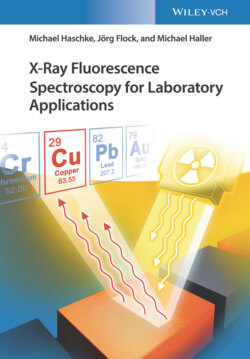Читать книгу X-Ray Fluorescence Spectroscopy for Laboratory Applications - Michael Haschke, Jörg Flock - Страница 2
Table of Contents
Оглавление1 Cover
2 Title Page
3 Copyright
4 Preface
5 List of Abbreviations and Symbols
6 About the Authors
7 1 Introduction
8 2 Principles of X-ray Spectrometry 2.1 Analytical Performance 2.2 X-ray Radiation and Their Interaction 2.3 The Development of X-ray Spectrometry 2.4 Carrying Out an Analysis
9 3 Sample Preparation 3.1 Objectives of Sample Preparation 3.2 Preparation Techniques 3.3 Preparation of Compact and Homogeneous Materials 3.4 Small Parts Materials 3.5 Liquid Samples 3.6 Biological Materials 3.7 Small Particles, Dust, and Aerosols
10 4 XRF Instrument Types 4.1 General Design of an X-ray Spectrometer 4.2 Comparison of Wavelength- and Energy-Dispersive X-Ray Spectrometers 4.3 Type of Instruments 4.4 Commercially Available Instrument Types
11 5 Measurement and Evaluation of X-ray Spectra 5.1 Information Content of the Spectra 5.2 Procedural Steps to Execute a Measurement 5.3 Selecting the Measurement Conditions 5.4 Determination of Peak Intensity 5.5 Quantification Models 5.6 Characterization of Layered Materials 5.7 Chemometric Methods for Material Characterization 5.8 Creation of an Application
12 6 Analytical Errors 6.1 General Considerations 6.2 Types of Errors 6.3 Accounting for Systematic Errors 6.4 Recording of Error Information
13 7 Other Element Analytical Methods 7.1 Overview 7.2 Atomic Absorption Spectrometry (AAS) 7.3 Optical Emission Spectrometry 7.4 Mass Spectrometry (MS) 7.5 X-Ray Spectrometry by Particle Excitation (SEM-EDS, PIXE) 7.6 Comparison of Methods
14 8 Radiation Protection 8.1 Basic Principles 8.2 Effects of Ionizing Radiation on Human Tissue 8.3 Natural Radiation Exposure 8.4 Radiation Protection Regulations
15 9 Analysis of Homogeneous Solid Samples 9.1 Iron Alloys 9.2 Ni–Fe–Co Alloys 9.3 Copper Alloys 9.4 Aluminum Alloys 9.5 Special Metals 9.6 Precious Metals 9.7 Glass Material 9.8 Polymers 9.9 Abrasion Analysis
16 10 Analysis of Powder Samples 10.1 Geological Samples 10.2 Ores 10.3 Soils and Sewage Sludges 10.4 Quartz Sand 10.5 Cement 10.6 Coal and Coke 10.7 Ferroalloys 10.8 Slags 10.9 Ceramics and Refractory Materials 10.10 Dusts 10.11 Food 10.12 Pharmaceuticals 10.13 Secondary Fuels
17 11 Analysis of Liquids 11.1 Multielement Analysis of Liquids 11.2 Fuels and Oils 11.3 Trace Analysis in Liquids 11.4 Special Preparation Techniques for Liquid Samples
18 12 Trace Analysis Using Total Reflection X-Ray Fluorescence 12.1 Special Features of TXRF 12.2 Sample Preparation for TXRF 12.3 Evaluation of the Spectra 12.4 Typical Applications of the TXRF
19 13 Nonhomogeneous Samples 13.1 Measurement Modes 13.2 Instrument Requirements 13.3 Data Evaluation
20 14 Coating Analysis 14.1 Analytical Task 14.2 Sample Handling 14.3 Measurement Technology 14.4 The Analysis Examples of Coated Samples
21 15 Spot Analyses 15.1 Particle Analyses 15.2 Identification of Inclusions 15.3 Material Identification with Handheld Instruments 15.4 Determination of Toxic Elements in Consumer Products: RoHS Monitoring 15.5 Toxic Elements in Toys: Toys Standard
22 16 Analysis of Element Distributions 16.1 General Remarks 16.2 Measurement Conditions 16.3 Geology 16.4 Electronics 16.5 Archeometric Investigations 16.6 Homogeneity Tests
23 17 Special Applications of the XRF 17.1 High-Throughput Screening and Combinatorial Analysis 17.2 Chemometric Spectral Evaluation 17.3 High-Resolution Spectroscopy for Speciation Analysis
24 18 Process Control and Automation 18.1 General Objectives 18.2 Off-Line and At-Line Analysis 18.3 In-Line and On-Line Analysis
25 19 Quality Management and Validation 19.1 Motivation 19.2 Validation
26 Appendix A: Tables
27 Appendix B: Important Information B.1 Coordinates of Main Manufacturers of Instruments and Preparation Tools B.2 Main Suppliers of Standard Materials B.3 Important Websites B.4 Laws and Acts, Which Are Important for X-Ray Fluorescence
28 References
29 Index
30 End User License Agreement
